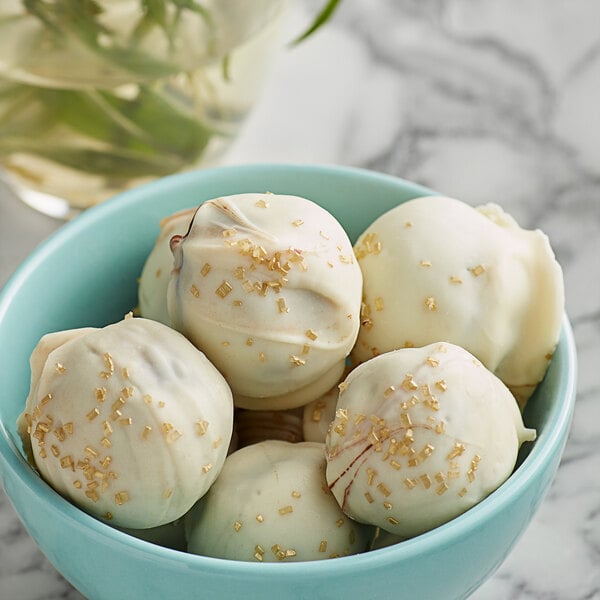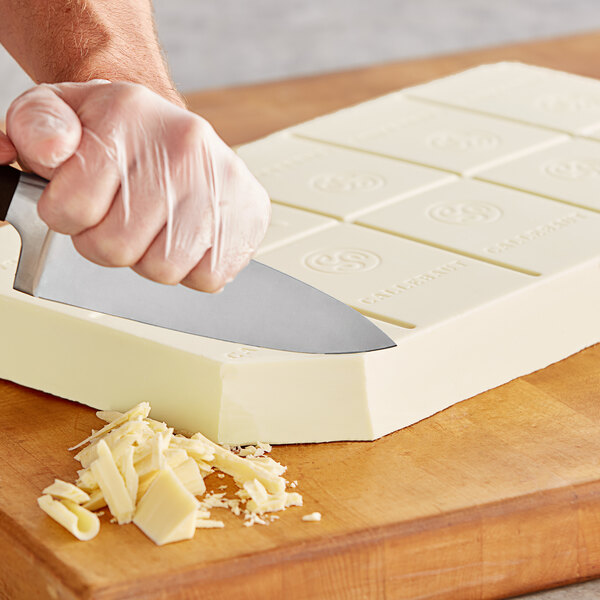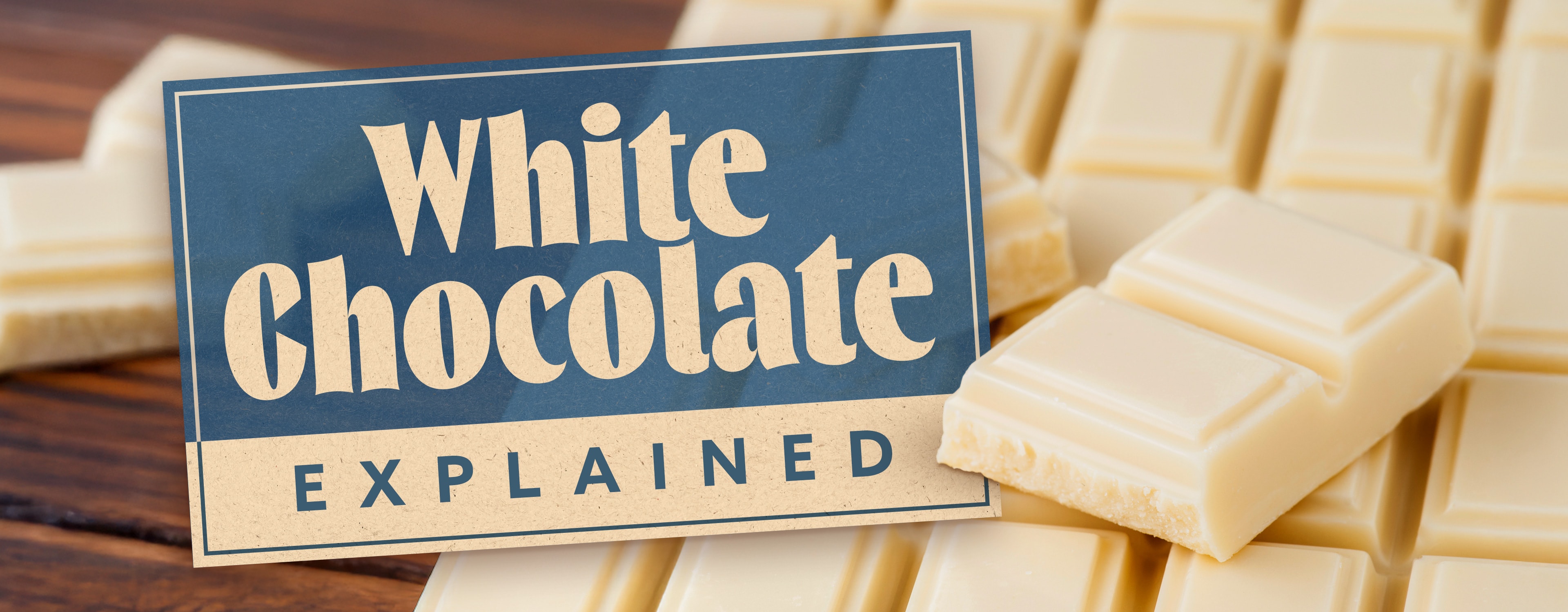What Is White Chocolate?
Last updated on Jan 23, 2025Corrinn McCauleyWhite chocolate boasts a pale ivory color and buttery, sweet, and milky flavor that is perfect for enjoying solo or as a sweet and creamy enhancement to coffee drinks and confectionaries. White chocolate has an albino appearance because it doesn't contain any cocoa solids. The absence of cocoa solids makes some skeptics question if white chocolate is "real" chocolate or a different type of candy altogether. We explain everything you need to know about this sweet treat so you can incorporate it into your confections or make chocolate candies.
What Is White Chocolate Made Of?

Unlike dark or milk chocolate which uses multiple parts of the cocoa bean, white chocolate contains no cocoa powder or chocolate liquor. Instead, it is primarily made of cocoa butter combined with sugar, milk solids, and desired flavoring agents like vanilla. Cocoa butter is the fat extracted from cocoa beans and provides white chocolate with its trademark smooth and rich mouthfeel.
Is White Chocolate Chocolate?
Because it doesn’t contain cocoa powder, people debate whether white chocolate is real chocolate. According to the Food and Drug Administration (FDA), white chocolate is a legitimate type of chocolate. In 2002, the FDA established a standard of identity for white chocolate, ensuring it meets specific criteria. This standard applies to imported and domestic white chocolate products, ensuring consistency and quality.
To meet FDA standards, white chocolate must contain specific components. White chocolate must contain at least 20% cocoa butter, 14% total milk solids, 3.5% milkfat, and no more than 55% sugar. These precise proportions ensure that white chocolate maintains its characteristic texture and flavor.
What Does White Chocolate Taste Like?
Known for its sweet, buttery, and creamy flavor, white chocolate boasts hints of vanilla and fresh milk. White chocolate's subtle taste is an excellent base for incorporating other flavors. Whether it's fruity notes, nutty undertones, or caramel accents, white chocolate provides a versatile canvas for creating a wide range of flavor combinations.
How Is White Chocolate Made?

Making chocolate is a complex process, and white chocolate follows unique steps. We explain how chocolate shops make white chocolate below:
- Ingredients Selection: The main components of white chocolate are cocoa butter, sugar, milk solids, and vanilla. Cocoa butter is the key ingredient that provides the rich and smooth texture of white chocolate. The higher quality of each element produces a better-tasting white chocolate.
- Cocoa Butter Extraction: To make white chocolate, candy makers extract cocoa butter from cocoa beans. The cocoa beans are roasted, cracked, and then pressed to separate the cocoa butter from the cocoa solids.
- Mixing Ingredients: Once the cocoa butter is extracted, it is combined with sugar, milk solids, and vanilla. The mixture is heated and stirred until all the ingredients are well combined.
- Conching Process: The mixture is then subjected to a process called conching, which involves continuously stirring and aerating the mixture to develop the smooth and creamy texture of white chocolate. This process also helps refine the flavor of the white chocolate.
- Tempering: After conching, the white chocolate is tempered to create a glossy finish and a satisfying snap when broken. Chocolate tempering involves heating and cooling the chocolate to specific temperatures while continuously stirring to stabilize the cocoa butter crystals.
- Molding and Setting: Once tempered, the white chocolate is poured into molds and set at a controlled temperature. This step ensures that the white chocolate solidifies properly and retains its shape.
- Packaging: After the white chocolate sets, it is removed from the molds, inspected for quality, and packaged for distribution and consumption.
White Chocolate Melting Point
White chocolate has a low melting point around 100 to 110 degrees Fahrenheit. For reference, dark chocolate has a melting point ranging from 113 to 120 degrees Fahrenheit and most milk chocolate melts between 104 and 115 degrees Fahrenheit. This low melting temperature makes white chocolate one of the trickiest chocolates to ship, requiring careful handling and temperature control to prevent melting during transit.
Is White Chocolate Good for You?
White chocolate falls short of its dark chocolate counterpart in health benefits. Many of the health benefits associated with chocolate come from cocoa solids, and white chocolate does not contain any cocoa solids. It's high in saturated fats due to its cocoa butter content, which can increase cholesterol levels and the risk of heart disease.
White chocolate also contains a significant amount of sugar. While white chocolate may be a delicious indulgence, it is important to enjoy it in moderation. If you are looking for a healthier alternative, dark chocolate with a higher cocoa content is a better choice as it contains antioxidants and other beneficial compounds that can impact health positively.
White Chocolate Purchasing Considerations

When purchasing chocolate for commercial use, there are several important considerations to help select the best white chocolate for your needs.
- Cocoa Butter Content: Check the cocoa butter content when purchasing white chocolate. Premium white chocolate has a high percentage of cocoa butter, resulting in a smoother texture and richer flavor.
- Brand Reputation: Choosing a reputable brand when purchasing white chocolate is crucial as it can guarantee consistency in quality and flavor. Established brands often have strict quality control measures to ensure their products meet the highest standards.
- Packaging: Opt for white chocolate that is well-packaged to maintain its freshness and prevent any contamination. Look for products sealed in airtight packaging to preserve their flavor and texture.
- Certifications: Consider purchasing white chocolate certified by reputable organizations such as Fair Trade or Rainforest Alliance. These food certifications ensure it was sourced ethically and sustainably, which can be important to customers looking to support responsible practices.
- Usage: Determine the intended use of the white chocolate before purchasing. Whether you are using it for baking, confectionery, or as a topping, selecting the right type of white chocolate with the appropriate melting point and flavor profile is essential for achieving the desired results.
- Price: While price is a consideration, it should not be the sole determinant when purchasing white chocolate. Investing in higher-quality white chocolate may result in better-tasting products and satisfied customers, ultimately benefiting your business in the long run.
White chocolate has a wide range of applications in the commercial food industry. Its creamy texture and sweet flavor make it a versatile ingredient for creating delectable desserts, pastries, and confections. Whether used in baking, as a coating for candies, or as a flavoring in beverages, white chocolate adds a touch of elegance and indulgence to any dish.








